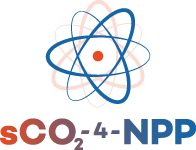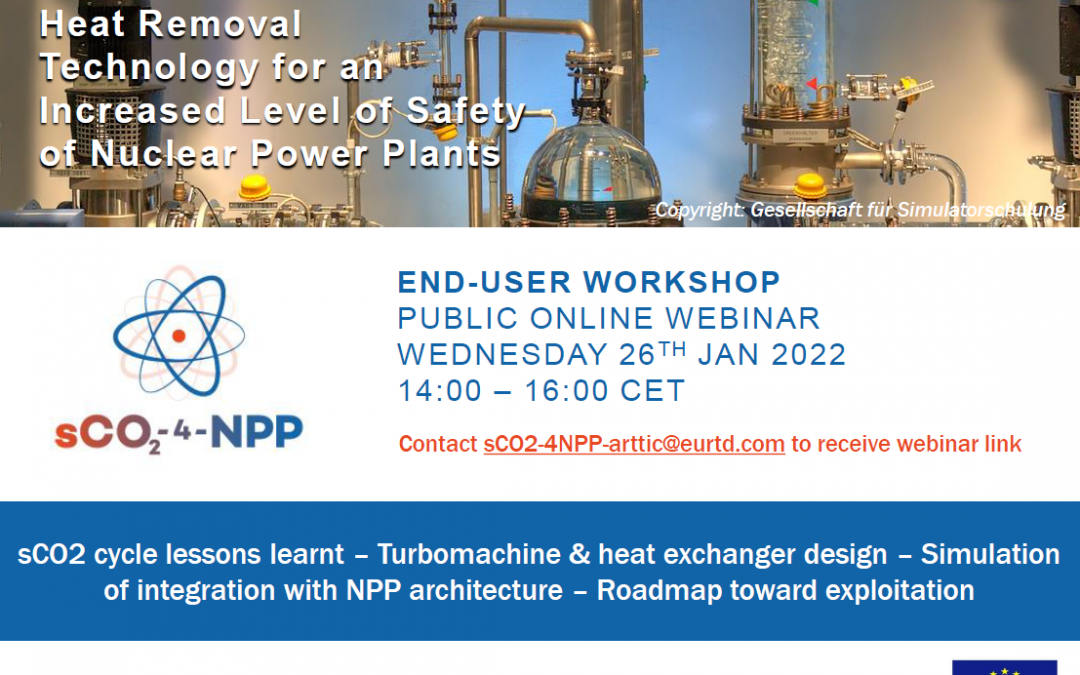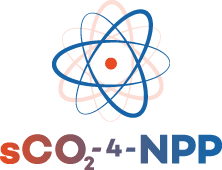Technical Objectives and Methodology
The overall aim of sCO2-4-NPP is to contribute to an increased safety of Nuclear Power Plants (NPPs) in case of accidents by further specifying, designing and validating the sCO2-based heat removal system developed in the previous sCO2-HeRo project on a NPP and preparing the necessary roadmaps to bring it closer to industrial use.
By bringing the system closer to market, sCO2-4-NPP will provide a heat removal solution for NPPs that will increase the grace period in case of accidents to beyond 72 hours (compared to a grace period in current reactors of ~48 hours), delaying the need for human intervention in case of an accident and thus decreasing the risk of human errors and the spread of radioactive material into the surrounding environment, ultimately reducing harm to both workers and citizens. The sCO2-4-NPP solution will be independent of the type of reactor operated (BWR, PWR, VVER, HTR, etc.) and will have the possibility to be retrofitted to the majority of current reactors in Europe as well as being integrated into future reactors.

In the former sCO2-HeRo project, the concept was validated in laboratory conditions to TRL3. In sCO2-4-NPP, the complete system will be further developed to reach TRL5 (technology validated in relevant environment) and parts of it will reach TRL6-7. To achieve this, the following technological and innovation objectives have been defined:
Objective 1: Validation of sCO2 models in thermal-hydraulic system codes on lab scale
To allow for necessary simulations of the sCO2-4-NPP system in a nuclear environment, the sCO2 models will be validated in the thermal-hydraulic system codes ATHLET and CATHARE (system codes used for reactor transient simulations, accepted in many licensing processes) and the Modelica code (real time running code to simulate parametric studies of the sCO2-HeRo loop) by means of experiments carried out on the 200 kWth sCO2-HeRo loop installed at GfS.
In addition, the models for turbomachinery, compact heat exchangers and the control system will be assessed for ATHLET, CATHARE and Modelica as an important step of the validation procedure from TRL3 (experimental proof of concept) to TRL4 (technology validated in lab).
Targeted result: ATHLET and CATHARE reproduce data of the sCO2-HeRo loop taking into account known uncertainties related to the codes.
Objective 2: Specification of an upscaled system, boundary conditions and simulations for implementation of an sCO2-4-NPP loop in a full-scale NPP (PWR)
In the sCO2-HeRo Project, upscaling of components led to the design of an sCO2 loop for BWR and VVER reactors. In sCO2-4-NPP, the design of the sCO2 loop will be upgraded for implementation on a PWR-type NPP where it will be attached to the steam generator of the secondary loop to safely and reliably remove heat for conditions which would lead to severe accidents without countermeasures. It is the ambition that by implementing the sCO2-cycle conditions the reactor can be cooled sufficiently without external grid connection, without emergency diesels, and without using the existing heat sink. The PWRs that will be concerned represent almost the entire PWR fleet of European large-scale NPPs. Based upon the results of accident simulations, specifications for the design will be available providing important boundary conditions, as well as heat removal capacity.
Targeted results: Specifications of sCO2-4-NPP system modules (number, power, expected performance) that safely and reliably remove decay heat produced by ATHLET and CATHARE simulations.
Objective 3: Preparation of a licensing roadmap of the sCO2-4-NPP system to ensure compliance with applicable regulation
This objective is critical for the adoption of the sCO2-4-NPP technology by utilities, and hence for shortening the time to market. sCO2-4-NPP will identify requirements on the system arising from licensing and regulation and ensure that they are included in the design process of components and system architecture. In addition, the partners will prepare a roadmap of future steps to achieve licensing by nuclear authorities.
The foreseen Defence in Depth (DID) level 4a will be assessed and requirements for system design will be specified. The selection of the DID level will serve as boundary conditions for the operation of the system, application of safety principles (redundancy), etc.
Targeted results: Identification of requirements for DID level 4a, initiation of licensing process, and licensing roadmap to reach TRL9.
Objective 4: Design of components for the sCO2-4-NPP loop in the context of licensing requirements (turbomachinery, heat exchanger, auxiliary systems)
As mentioned above, the design of components within the framework of nuclear licensing is an important step to enable the adoption of sCO2-4-NPP by nuclear authorities and NPP operators. This is especially true for new types of components to be attached to the steam generator of a NPP. The detailed design of the sCO2-4-NPP components (turbomachinery, heat exchangers and auxiliary systems) will therefore be specified taking into account regulatory requirements. This detailed design will define the dynamic behaviour of the sCO2 cycle, which is required for the system architecture (objective 5) and the validation of sCO2-4-NPP loop (objective 6). Results from work on component design and prototyping in the ongoing H2020 sCO2-Flex project coordinated by EDF and with many partners also involved in sCO2-4-NPP will support the achievement of this objective. Robustness of the turbomachinery will also be improved by the development of an improved small-scale turbomachine to be included in the sCO2-HeRo loop built in the previous project.
Targeted results: CAD designs of components that comply with nuclear licensing requirements available and key performance data (dimensions, masses, efficiencies, etc.) documented.
Objective 5: Final design of the system architecture of sCO2-4-NPP integrated in a full-scale NPP
This objective will demonstrate the capability for retrofitting the sCO2-4-NPP system into existing PWRs with minimal impact on the reactors and will provide the necessary information to integrate the system into a future reactor by identifying necessary auxiliaries and the footprint. A 1:1 scale design of sCO2-4-NPP modules integrated into a PWR will be developed and numerical accident simulations will be carried out using ATHLET and CATHARE to assess the reliable heat removal of the resulting sCO2-4-NPP modules. The interaction with different active safety systems or severe accident safety measures will be simulated with ATHLET and CATHARE to demonstrate that the sCO2-4-NPP system will not negatively interact with active safety systems installed at PWRs.
Targeted results: CAD drawings of 1:1 scale design of sCO2-4-NPP modules integrated in PWR and safe heat removal of the designed system validated by ATHLET and CATHARE simulations.
Objective 6: Validation of sCO2-4-NPP loop in a virtual “relevant nuclear environment” PWR
TRL5 (technology validated in relevant environment) will be achieved by using a unique virtual relevant nuclear environment: a real scale training simulator of a German PWR. The PWR simulator that will be used provides a unique opportunity to assess the operation and interaction of the sCO2-4-NPP technology with a real NPP without neutrons. Other than testing on an operating NPP (which is not possible for safety reasons), using such a training simulator is the environment closest to reality that exists. Using the results from ATHLET/Modelica, a fast running model that will simulate the interaction of the sCO2-4-NPP cycle with the PWR will be derived and programmed into the software of the training simulator. Several accident sequences will be simulated and assessed.
Another important aspect of the virtual integration of the sCO2-4-NPP system into the training simulator is that it allows NPP operators to become familiar with the new sCO2-4-NPP system. An easier market entrance is achievable by demonstrating how the system can be retrofitted to the PWR with minimal associated changing of the plant.
Targeted results: Operation of sCO2-4-NPP integrated into the KONVOI NPP simulator without negatively interfering with the existing safety and operational systems, validation that the grace period can be extended to beyond 72 hrs and that the decay heat is safely removed from the core to the diverse ultimate heat sink (air, air cooling towers).
Objective 7: Prepare technical, regulatory, financial and organisational roadmaps to bring sCO2-4-NPP to market
To prepare the required steps after the project to bring the sCO2-4-NPP system to market, roadmaps for technical fine-tuning, demonstration activities, financial, regulatory and logistic requirements of the system will be defined. This will provide important input to the exploitation plan for the sCO2-4-NPP technology and will allow a direct continuation of activities after the end of the project to bring the system all the way to the market.
Targeted results: Detailed technical, regulatory, financial and organisational roadmaps for bringing sCO2-4-NPP to market.



